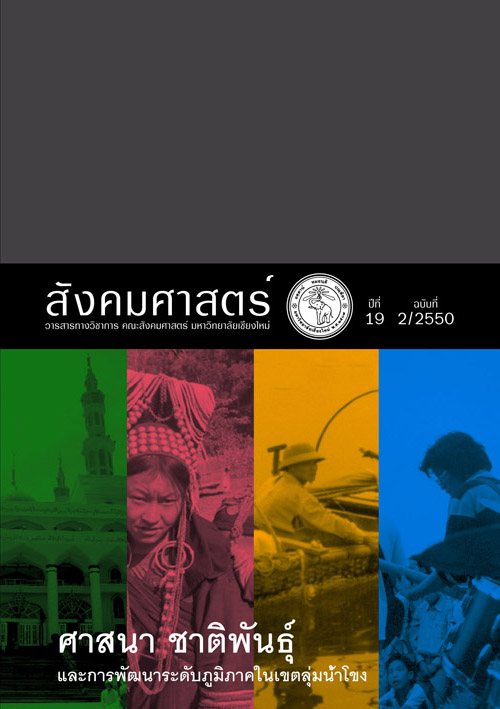เสียงไตลื้อ การเดินทาง/เคลื่อนที่ของพลเมืองลื้อ สิบสองปันนา
Main Article Content
Abstract
This paper discusses cultural formation of modern Dai music, focusing particularly on the formation of one pop band by the name ‘Saeng Tai Lue’ and its stories. Cultural formation of the ‘New Music of Banna’ shows a process of transnational mobilities, both of moving bodies (regional travellers, traders, and cross-border monks), and cultural media (radio, audio cassettes, CDs and VCDs of music and films) which play a crucial role in the cultural revival process of the Dai nationality minority (the Lue of Sipsong Panna) in modern China. The band stories reflect how, on the one hand, these mobilities have emerged in response to changing state policies on border regulations. On the other hand, they also react on how these mobilities have ironically challenged the ways the Chinese state exercise power on its Dai nationality minority citizens. Moreover, the formation of the band and its stories that within the changing contexts of national and regional development, there are spaces whereby minority citizens can tactically mobilities themselves to survive, develop, and even enhance their local cultures and societies.
Article Details
All written articles published on Journal of Social Sciences is its author’s opinion which is not belonged to Faculty of Social Sciences, Chiang Mai University or is not in a responsibility of the journal’s editorial committee’s members.
References
ประคอง นิมมานต์เหมินทร์ และ ทรงศักดิ์ ปรางค์วัฒนกุล (บรรณาธิการ)เชียงใหม่: ศูนย์หนังสือเชียงใหม่.
ชัยอนันต์ สมุทวณิช 2544 จากรัฐชาติสู่รัฐตลาด, กรุงเทพ: สำนักพิมพ์บ้านพระอาทิตย์.
บุญช่วย ศรีสวัสดิ์ 2547 30 ชาติในเชียงราย, พิมพ์ครั้งที่ 2: กรุงเทพฯ, ศยาม.
วสันต์ ปัญญาแก้ว 2543 “ชาติพันธ์ุวิธีวิทยา” วารสารสังคมศาสตร์ (มหาวิทยาลัย
เชียงใหม่) ปีที่ 12 ฉบับที่ 1.
2548 “อำนาจรัฐกับการเดินทาง/เคลื่อนที่ของพลเมืองลื้อ” วารสารสังคมศาสตร์ (มหาวิทยาลัยเชียงใหม่) ปีที่ 17 ฉบับที่ 1: 173-202.
2550 เสียงไตลื้อ-สิบสองปันนา: การเดินทาง/เคลื่อนที่ ความเป็นถิ่นฐานและการเคลื่อนย้ายถ่ายโอนวัฒนธรรมข้ามพรมแดน (รัฐชาติ), เชียงใหม่: ภาควิชาสังคมวิทยาและมานุษยวิทยา มหาวิทยาลัยเชียงใหม่ (เอกสารรายงานการ
วิจัย).
สิงฆะ วรรณสัย 2518 พุทธตํานานพระเจ้าเลียบโลก, (ปริวรรตจากคัมภีร์ใบลาน),
เอกสารอัดสำเนา.
แสวง มาละแซม 2540 คนยองย้ายแผ่นดิน, กรุงเทพฯ: สำนักพิมพ์มหาวิทยาลัย
ธรรมศาสตร์.
Akin Rabibhadana 1975 “Clientship and Class Structure in the Early Bangkok Period”, in Change and Persistence in Thai Society, edited
by G. William Skinner and A. Thomas Kirsch, Ithaca and London:
Cornell University Press.
Battersby, Paul 1999 “Border Politics and the Broader Politics of Thailand’s International Relations in the 1990s: From Communism to Capitalism”, Pacifc Affairs, Vol. 71, No. 4. (Winter, 1998-1999): 473-488.
Cohen, Paul T. 2000 “Lue across Borders: Pilgrimage and the Muang
Sing Reliquary in Northern Laos”, in Grants Evans, Christopher Hutton, & Kuah Khun Eng (eds) Where China meets Southeast Asia, Singapore: Institute of Southeast Asian Studies: 145-161.
2001 “Buddhism Unshackled: The Yuan ‘Holy Man’ Tradition and the Nation-State in the Tai World”, Journal of Southeast Asian Studies, Vol. 32, No. 2: 227-247.
2002 “The Lue Diaspora”, paper presented at The 8th International
Conference on Thai Studies, Nakhon Phanom, Thailand, 9-12 January 2002.
Davis, Sara 1999 “Singers of Sipsongbanna: folklore and authenticity in
contemporary China”, Ph.D. Dissertation, University of Pennsylvania.
2003“Premodern Flows in Postmodern China: Globalization and the
Sipsongpanna Tais”, Modern China, Vol. 29, No. 2 (April): 176-203.
Geertz, Clifford 1980 Negara: The Theatre State in Nineteenth-Century
Bali, Princeton University Press.
Grabowsky, Volker 1999 “Forced Resettlement Campaigns in Northern
Thailand and During the Early Bangkok Period, Journal of the Siam
Society, Vol. 87, No. 1 & 2: 45-86.
Hsieh, Shih-Chung 1989 Ethnic-Political Adaptation and Ethnic Change of
the Sipsong Panna Dai: An Ethnohistorical Analysis, Ph.D. Dissertation, University of Washington, Seattle.
1995 “On the Dynamics of Tai/Dai-Lue Ethnicity: An Ethnohistorical
Analysis”, in Cultural encounters on China’s ethnic frontiers, edited by
Steven Harrell, Seattle: University of Washington Press: 301-328.
2002 “Three Mini-communities, One Loosen Yunnanese-Paiyi Community, and One Non-integrated Ching-ching ‘Community’: Ethnicity and Social Relationship in a State Farm, Central Taiwan”, paper presented in The 8th International Conference on Thai Studies, Nakhon Phanom Province, Thailand, January 9-12, 2002.
Hyde, Sandra 2001 “Tourism Practices on the Periphery: Eroticizing
Ethnicity and Pathologizing Sex on the Lancang”, in China Urban:
Ethnographies of Contemporary China, edited by Nancy N. Cohen,
Constance D. Clark, Suzanne Z. Gottschang, and Lyn Jeffery, Durham
& London: Duke University Press.
Keyes, Charles F. 1992 “Who are the Lue Revisited? Ethnic Identity in
Laos, Thailand, and China”, Working Paper, Centre for International Studies. Cambridge: MIT.
Lebar, Frank M. and Gerald C. Hickey, John K. Musgrave 1964 Ethnic
Groups of Mainland Southeast Asia, New Heaven: Human Relations Area Files Press.
McCarthy, Susan 2000 “Ethno-Religious Mobilisation and Citizenship
Discourse in People’s Republic of China”, Asian Ethnicity, Vol. 1, No. 2: 107-116.
Moerman, Michael 1965“Ethnic Identifcation in a Complex Civilization: Who
are the Lue?”, American Anthropologist, Vol. 67, No. 5 (Part 1): 1215-1230.
Scott, James C. 1998 “Freedom and Freehold: Space, People and State
Simplifcation”, in Asian Freedoms, edited by David Kelly and Anthony Reid,
Cambridge: Cambridge University Press: 37-64.
1998 Seeing Like A State, New Haven: Yale University Press.
1999 “The State and People Who Move Around: How the valleys make the
hills in Southeast Asia”, IIAS Newsletter, Vol. 19, (June): 3, 45.
Tapp, Nicholas 1995 “Minority Nationality in China: Policy and Practice” in
Indigenous Peoples of Asia, edited by R. H. Barnes, Andrew Gray, and
Benedict Kingsbury, Michigan: Monograph of the Association for Asian
Studies; no. 48: 195-220.
Turton, Andrew 1980 “Thai institutions of Slavery” in Asian and African Systems of Slavery, edited by James L. Watson, Oxford: Blackwell: 251-292.
2000 “Introduction to Civility and Savagery, in Civility and Savagery, edited
by Andrew Turton Richmond, Surrey: Curzon: 3-31.
Vandergeest, Peter 1993 “Constructing Thailand: Regulation, Everyday
Resistance, and Citizenship”, Comparative Studies in Society and History,
Vol. 35, No. 1: 133-158.
Walker, Andrew 1999 The Legend of the Golden Boat, Richmond: Curzon.
Wijeyewardene, Gehan 1990 “Thailand and the Tai: Versions of Ethnic Identity” in Ethnic groups across national boundaries in mainland Southeast Asia, edited by Gehan Wijeyewardene, Singapore, Institute of Southeast Asian Studies: 48-73.
1993 “Ethnicity and Nation: The Tai in Burma, Thailand and China (Sipsong Panna and Dehong)” paper presented at The 5th International Conference on Thai Studies, SOAS, London.
Wyatt, David K. 2003 Thailand: A Short History, 2nd edition, New Haven and London: Yale University Press


